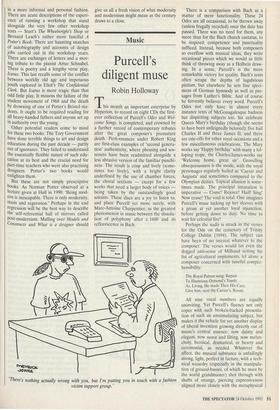Design
Inescapably modern
Tanya Harrod on the visionary work of Norman Potter
In recent years the job description 'designer' has come to imply some kind of deception coupled with a spurious glam- our. Very few of us understand the creative Processes of serious design or the special nature of design and architectural training. On architectural training there is now Don- ald Schon's illuminating book The Design Studio. But the classic text is surely Nor- man Potter's What is a designer — a book Which should be read by anyone with the Slightest interest in the subject. As Potter Points out, in this country the gulf between the essential activities of designing and constructing and that of the university- based book-learning culture is immense — far greater than the famous arts/sciences divide identified by C.P. Snow. What is a designer first appeared in 1969, at a time when Potter was himself wonder- ing about the future of art education in the aftermath of the student sit-ins. He had previously taught at the Royal College of Art and at one point seemed a possible candidate for the Rectorship. It was a long shot, but a Christian anarchist who had drunk at the purest springs of European modernism would have been an inspired choice. In 1968 Potter was head of the School of Construction at the West of Eng- land College of Art. He had built up the course there in a fashion that recalled other momentous experiments in design education — above all the Bauhaus and the Hochschule für Gestaltung at Ulm. Not surprisingly his sympathies were with the students in their revolution and he support- ed them, turning his back on the Establish- ment and putting his own job on the line. What is a designer was, therefore, a work of reparation for lost hopes — an elevated, beautiful book imbued with moral respon- sibility which also contained a pithy analy- sis of the failings of British art education.
The roots of the book lay, however, in Potter's own design experience during the 1950s, when he ran a highly unusual small workshop at Corsham. A rural workshop suggests an Arts and Crafts affair which might owe something — especially in the West Country — to the Cotswold school associated with the Barnsleys and with
Ernest Gimson. Potter certainly has his heroes from the high plains of the Arts and Crafts world: W.R. Lethaby, C.R. Ashbee, William Morris and Peter 1Cropotkin, for instance. But his workshop was a construc- tive, small-scale response to the present — the kind of thing Lewis Mumford envis- aged for the mid-century when he wrote Technics and Civilisation in 1934. It was meant to be as accessible as a local garage. Yet it offered, on a genial, collaborative basis, undiluted modern movement design. Potter, in placing his workshop as near the centre of ordinary people's lives as possible — making modernism accessible — creat- ed something that was, in the best sense, marginal and dissenting.
The full account of Potter's workshop and a partial visual record of what came out of it can be found in his remarkable Models and Constructs, published, together with the reprint and update of What is a designer, by Hyphen Press. The two books are works of art in themselves, a perfect marriage of form and content, flowing from a true collaboration between Potter and his publisher Robin Kinross. Models and Con- structs in particular refreshes the eye with its austerity and reminds us that modernist book design is still alive and can be used creatively, not nostalgically.
But the book is far more than a delight for a modernist bibliophile. Parts of it develop themes from What is a designer but in a more informal and personal fashion. There are acute descriptions of the experi- ence of running a workshop that stand alongside the very few other workshop texts — Sturt's The Wheelwright's Shop or Bernard Leach's rather more fanciful A Potter's Book. There are haunting snatches of autobiography and accounts of design jobs carried out in the workshop years. There are exchanges of letters and a mov- ing tribute to the pianist Artur Schnabel. There is poetry and a lengthy verse play, Icarus. This last recalls some of the conflict between worldly old age and impetuous Youth explored in Eliot's The Confidential Clerk. But Icarus is more tragic than that odd little play. It mourns the failure of the student movement of 1968 and the death by drowning of one of Potter's Bristol stu- dents. It ought to be required reading for all heavy-handed fathers and anyone set up in authority over the young.
Other potential readers come to mind for these two books. The Tory Government have done terrible things to art and design education during the past decade — partly out of ignorance. They failed to understand the essentially flexible nature of such edu- cation at its best and the crucial need for Part-time teachers who were also practising designers. Potter's two books would enlighten them.
But these are not simply prescriptive books. As Norman Potter observed at a lecture given at Hull in 1990: 'Being mod- ern is inescapable. There is only modernity, stasis and regression.' Perhaps in the end regression will be the best way to describe the self-referential hall of mirrors called post-modernism. Mulling over Models and Constructs and What is a designer should
give us all a fresh vision of what modernity and modernism might mean as the century draws to a close.



































































 Previous page
Previous page